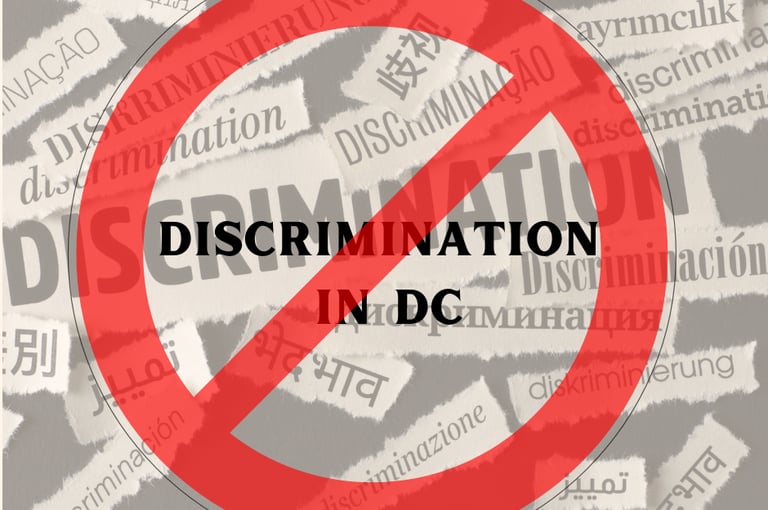The DC Human Rights Act: A Minefield for Small Business
The DC Human Rights Act is a very comprehensive anti-discrimination statute. All DC employees and employers need to understand it.
However, the DC Human Rights Act (DCHRA) is not so common-sense. It is one of the most comprehensive anti-discrimination statutes in the country and goes way beyond federal law in its protections of employees. An uninformed employer could be subject to devastating penalties if they don't understand and fulfill their obligations under DC law. And that's not all. Even an individual employee could be liable for discrimination. Therefore, it’s crucial for every employee and business owner in DC to understand their rights and responsibilities under the DC HRA!
To start with, here are four of the most significant differences between federal law and the DCHRA that anyone doing working or doing business in DC must understand. (There are more! Stay tuned for future blogs.)
1. Every employer is covered.
Under most federal anti-discrimination statutes, an employer with less than 15 employees is not covered. (The exception is the Age Discrimination in Employment Act, which only covers employers with at least 20 employees).
However, under DCHRA, every employer is covered as long as you have at least one employee. The definition of “employer” under the DCHRA is “any person who, for compensation, employs an individual, except for the employer’s parent, spouse, children or domestic servants, engaged in work in and about the employer’s household; any person acting in the interest of such employer, directly or indirectly; and any professional association.” DC Code § 2–1401.02(10)
So if you hire a nanny for your children or hire your son to mow the lawn, you aren’t covered. Otherwise, you pretty much are! Which leads us to our next point.
2. Individual employees and managers can be individually liable.
It’s right there in the definition. “[A]ny person acting in the interest of such employer.” That’s legal language for anyone employed to work for an employer and acting on the employer’s behalf. That could include a manager, supervisor, or even a non-supervisory employee. For example, an employee who sexually harasses another employee could be liable individually.
Under federal law, a company can be liable for an employee’s or manager’s actions, but the individual employee(s) or manager(s) themselves are not liable. I don’t think it requires much imagination to see that this could be a huge problem for any employee! Or for the employer.
3. There are no caps on compensatory damages.
Compensatory damages are damages successful plaintiffs receive to compensate them for the discrimination they suffered.
Under Title VII of the Civil Rights Act, the primary federal anti-discrimination statute, as well as under the Americans with Disabilities Act, there are caps on awards of compensatory damages, which includes compensation for emotional distress. For small business of 15-100 employees, that cap is $50,000. (That cap does not include compensation for past or future lost pay). It is progressively higher for larger companies. The maximum for the largest companies is $300,000. Under the Age Discrimination in Employment Act, compensatory damages are not allowed.
However, under the DCHRA, there are no caps. Therefore, even if your business only has one employee, you could theoretically be on the hook for tens of thousands, even hundreds of thousands of dollars if you’re found to be guilty of discrimination.
4. There are many more protected classes than under federal law.
Federal statutes protect the following protected classes: race, color, sex, national origin, religion, disability, age, and genetic information. In addition, in its 2020 decision Bostock v. Clayton County[1], the Supreme Court ruled that discrimination based on sexual orientation and transgender are also prohibited under federal law.
However, under the DCHRA there are 18 protected classes for employment discrimination.
These are: 1. Race 2. Color 3. Religion 4. National Origin 5. Sex 6. Age 7. Marital Status 8. Personal Appearance 9. Sexual Orientation 10. Gender Identity or Expression 11. Family Responsibilities 12. Genetic Information 13. Disability 14. Matriculation 15. Political Affiliation 16. Credit Information 17. DVSOS 18. Homeless Status (This is a new protected status since 2022)
I’ll discuss the meaning of the non-federal protected classes in future blogs, but for now, you should be aware of them.
So that’s a basic introduction to the DCHRA. There’s a lot more information to be covered, so stay tuned. In our next blog, we’ll discuss the 2022 amendments to the DCHRA. They included major changes which can affect employers and employees alike.
If you're a small business owner and you need a better understanding of these laws and how they affect your business, please contact me.
[1] 590 US ___(2020)


Most people are probably are familiar with at least the basics of employment discrimination law.
You know an employer can’t refuse to hire someone or fire them based on their race, sex, or national origin, for instance.
And you know an employer can’t retaliate against employees or applicants if they file a complaint against the employer.
You know an employer can’t harass their employees based on sex or other protected classes, or allow employees to harass each other.


